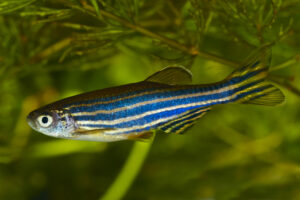Welcome – Zebrafish as a Model Organism
Zebrafish (Danio rerio) is a very common aquatic organism used in scientific research. It is also considered one of the top 5 most popular model organisms in all of scientific research among the likes of the house mouse (Mus musculus), the fruit fly (Drosophila melanogaster), yeast (Saccharomyces cerevisiae), and the worm (Caenorhabditis elegans).

The Doctor of Delayed Publications: The Remarkable Life of George Streisinger (1927–1984)
Zebrafish first came to be used in scientific because of the work of molecular biologist George Streisinger who was at the University of Oregon during the 1960s when he started first using zebrafish as a model organism in his laboratory. While he was not the first biologist to use zebrafish as an experimental organism, that would be Charles W. Creaser in 1934, to his peers he is considered to be the founding father of zebrafish research.
There are multiple reasons why zebrafish are an ideal model organism for multiple areas of scientific research. The initial reason why the tropical freshwater fish was so appealing to Streisinger was due to the organism’s process of embryogenesis. The process of fertilization and embryogenesis occurs outside of the organism, since the zebrafish lay their eggs outside of their body. This allows every stage of the developing embryo to be observed and thus is an ideal model for studying development and developmental disorders.
Additionally, the zebrafish and human genome are very similar, with around 70% of human genes having a zebrafish homolog (Li et al., 2013). Even more surprising is that a high percentage of genes that are associated with predisposing humans to disease are shared between the two vertebrates. This has allowed zebrafish to be genetically manipulated to create human disease models and to find treatments and therapeutics for countless diseases such as pediatric cancers, kidney disorders, and cardiovascular defects.
 Zebrafish fin and heart: what’s special about regeneration?
Zebrafish fin and heart: what’s special about regeneration?
Furthermore, there are countless other advances that have been enabled by studies using zebrafish. Strikingly, zebrafish have the unique ability to regenerate multiple different organs, including all of the fins, heart, retina, and kidney (Beffagna 2019). For this reason, zebrafish have been a key model for studying the unique biological and regenerative abilities of these organs.
